Thysdrus (El Djem), an ancient Roman town in today's Tunisia (original) (raw)
You may wish to see an introductory page to this section or a page on the amphitheatre of Thysdrus first.
The Archaeological Museum of El-Djem, the ancient Thysdrus, houses a series of mosaics found in the town or in its environs. It is a modern museum where the exhibits are displayed in a very effective way. It was built next to the House of Africa, thus named after a mosaic which is shown in the introductory page.
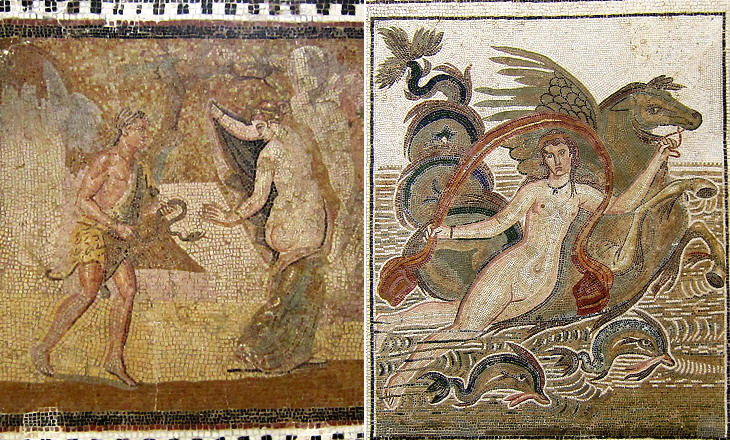
Central sections of mosaics: (left) satyr frightening a bacchant, both followers of Dionysus/Bacchus; (right) a Nereid, a sea nymph, a very popular subject: see mosaics at the Museum of Bardo in Tunis and at Hippo Regius in Algeria
The most elaborate mosaics were reserved to the triclinia, the formal dining rooms of the Romans. The name means three couches because the diners ate their meals reclining on couches or cushions placed on three sides of the room, forming a sort of U-shape table (see a triclinium at Pupput). A typical mosaic for a Roman triclinium had a small pictorial section (emblema) at its centre which the diners could admire during the meal. This section was made by a different person than that who took care of the decorative frame.
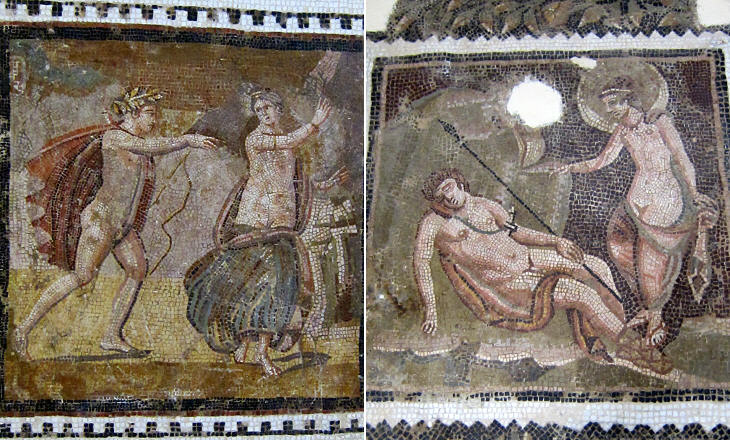
Central sections of mosaics: Greek myths made popular by Ovid's Metamorphoses: (left) Apollo and Daphne (see Gian Lorenzo Bernini's statues); (right) Selene and Endymion, a subject often depicted on sarcophagi
Apollo was not invariably successful in love. On one occasion he pursued Daphne, a mountain nymph and a priestess of Mother Earth; but when he overtook her, she cried out to Mother Earth who, in the nick of time, spirited her away to Crete and left a laurel-tree in her place, and from its leaves Apollo made a wreath to console himself.
Endymion was lying asleep in a cave one still night when Selene first saw him, lay down by his side, and gently kissed his closed eyes. Afterwards he fell into a dreamless sleep, because Selene found that she preferred gently kissing him to being the object of his too fertile passion. He has never grown a day older, and preserves the bloom of youth on his cheeks. From Robert Graves - The Greek Myths
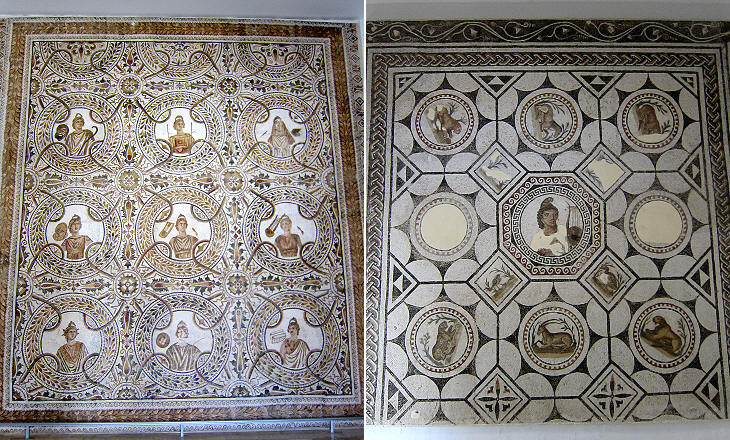
Large mosaics: (left) The Nine Muses; (right) Orpheus taming the beasts
The Romans did not have much furniture in their rooms and a decorative mosaic helped in avoiding a feeling of emptiness. In the above mosaics the emblema was multiplied by nine to increase its "filling" effect. The images were usually placed inside medallions; in some instances, as in the mosaic of the Muses, all images had the same orientation and they probably faced the room entrance, in other cases the orientations were different or converged towards the central image as at Vichten in Luxembourg.
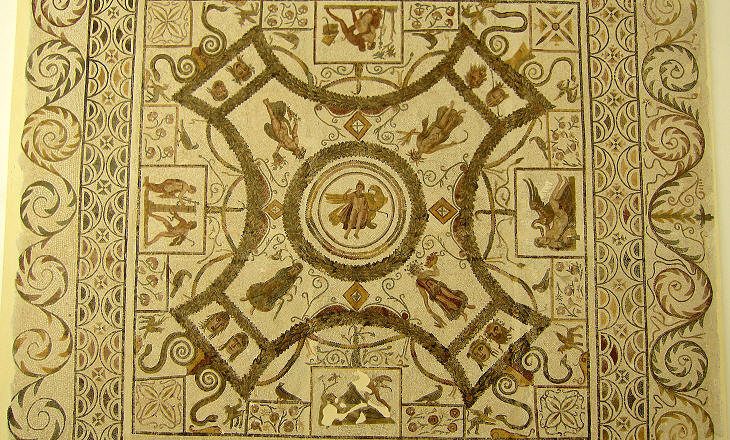
The Four Seasons and at the centre Zeus and Ganymedes and to its right Zeus and Leda; the Loves of Zeus were another subject for large mosaics as at Italica in Spain
The Four Seasons distributed around a central image were a very popular subject to create a mosaic with five focal points (see a [famous example at the Museum of Bardo](Bardo.html#Four Seasons)).
Ganymedes was the most beautiful youth alive and therefore chosen by the gods to be their cup-bearer. It is said that Zeus, desiring Ganymedes also as his bedfellow, disguised himself in eagle's feathers and abducted him.
According to the most usual account Zeus companioned with Leda in the form of a swan. She laid an egg from which were hatched Helen, Castor and Polydeuces. From Robert Graves - The Greek Myths.
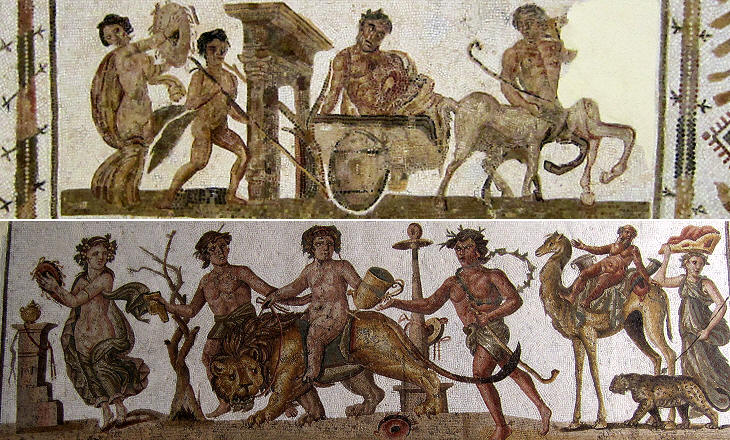
A "thiasos", a Dionysiac processions
Movies and TV serials have made two aspects of Roman life very popular: gladiatorial fights and indiscriminate sexual activity. Many mosaics found throughout the Roman Empire and portraying Dionysus surrounded by satyrs and maenads may have contributed to the latter. The meaning of these mosaics was rather complex and not limited to sexual aspects. The sound of the tambourines chased evil spirits away. Playing music, drinking and laughing were ways by which the ancient Greek and Romans faced the fact that Yet we mortals bear per-force what the gods send us, though we be grieved; for a yoke is set upon our necks. Hymn to Demeter - translated by Hugh G. Evelyn-White. This explains why they were so often depicted on sarcophagi, e.g. at Lyon.

An owl surrounded by birds: the inscription says: the birds are torn apart by envy and the owl doesn't care
I rather think that the emotion of jealousy is by far the fiercest of all, and needs as much energy for its repression as for its stimulation. Now people are especially jealous of their equals, or of those once beneath them, when they feel themselves left behind and fret at the others' upward flight.
Cicero - De Oratore - Book II - 209 - Translation by E. W. Sutton.
Evil spirits could take the form of envious thoughts and this mosaic was meant to protect the house from them; see another sentence against envy in a mosaic in this page and in one at Ostia.
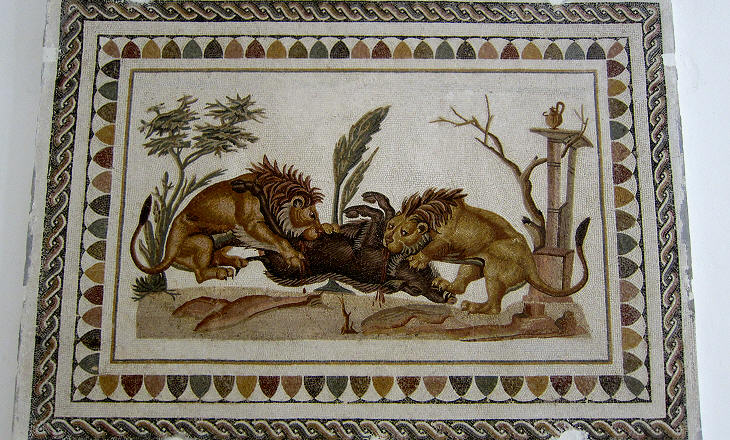
Lions assaulting a boar
The making of an elaborate mosaic required teamwork. Calcis coctor was in charge of preparing the mortar, the quality of which was key to ensure the duration of the mosaic. Pavimentarius prepared the floor by laying the lower layers of the mosaic. Tessellarius made the simpler parts of the mosaic such as geometric frames. Pictor musivarius executed the most elaborate sections based on drawings made by Pictor imaginarius. These last two activities were often combined.
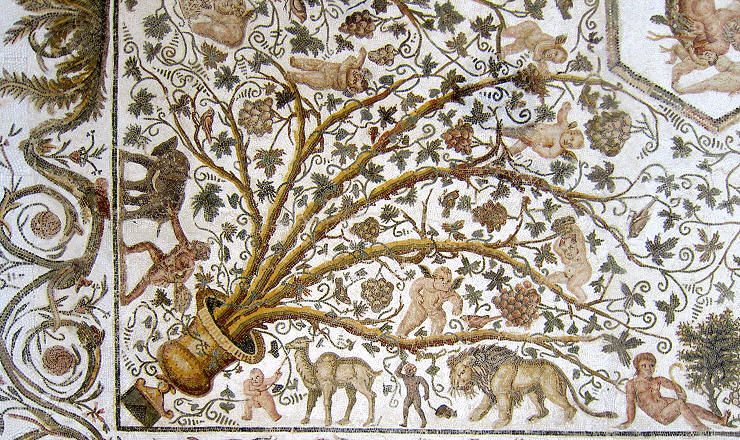
Kantharos (see a similar mosaic at Ippona)
This jar was a symbol of Dionysus. It was usually depicted with a grapevine growing from it, as in some Roman baths along Via Appia. It was adopted by the early Christians as a symbol of life in mosaics at Sufetula, Uppenna and Sousse. The same subject can be seen also at S. Costanza in Rome.
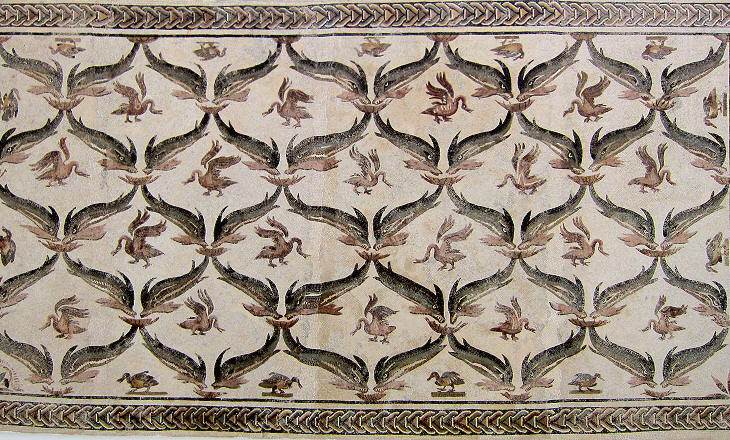
Decorative mosaic with dolphins and swans; its geometric pattern can be noticed also in a mosaic at the Archaeological Museum of Sousse
Almost all of the mosaics in the museum hang on the walls, something which in some cases make them resemble tapestries. The choice of depicting dolphins and swans together was not dictated only by aesthetic aspects, but also by their both being sacred to Apollo.
When Leto bore Apollo on the then floating island of Delos, swans surrounded her to hide the delivery from Hera. Apollo sent dolphins to rescue Arion, a famous lyre player who, before throwing himself into the sea from a pirates' ship, sang a song of praise to the god.
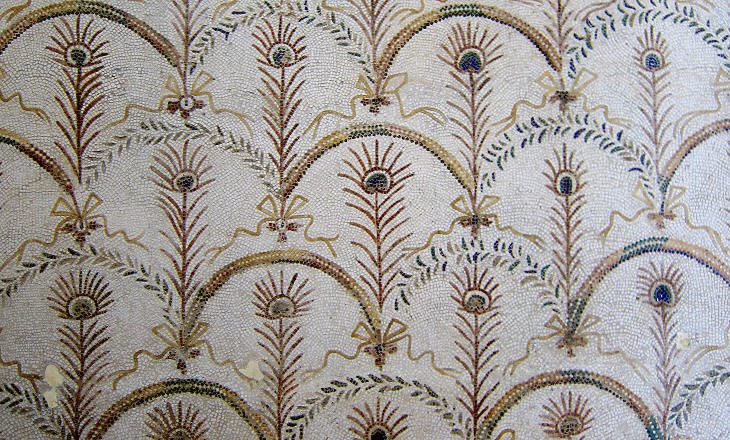
Peacock feathers
This very decorative mosaic depicting peacock feathers has a link to Greek myths.
Io was a priestess of Hera and Zeus fell in love with her. When Hera charged him with infidelity he turned Io into a white cow, which Hera claimed as hers and handed over to Argus Panoptes, a giant with one hundred eyes. Zeus sent Hermes to steal Io. Hermes crushed Argus with a boulder after having made him fall asleep by playing the flute. Hera placed Argus' eyes in the tail of a peacock. From Robert Graves - The Greek Myths. Learn more about this myth.
The eyes on the peacock feathers had the power of detecting and chasing evil spirits.
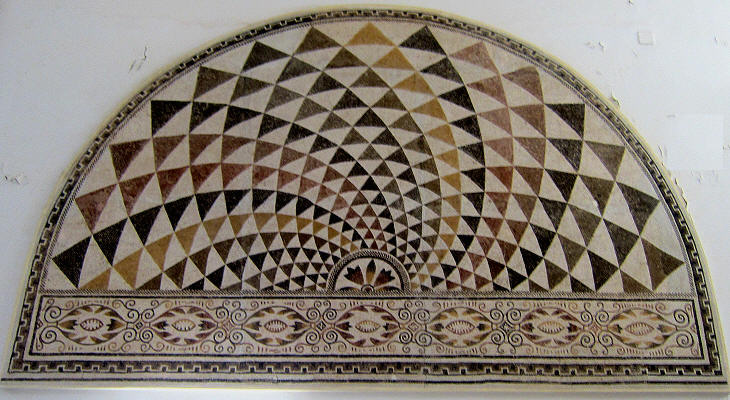
Mosaic having an optical effect
Decorative mosaics eventually developed patterns which were entirely meant to obtain an aesthetic effect with no links to real things or mythical personages. In essence it was an early form of abstract art. See similar mosaics at Cirta in Algeria, Dion in Greece and Salamis on Cyprus.
Museum of Bardo in Tunis
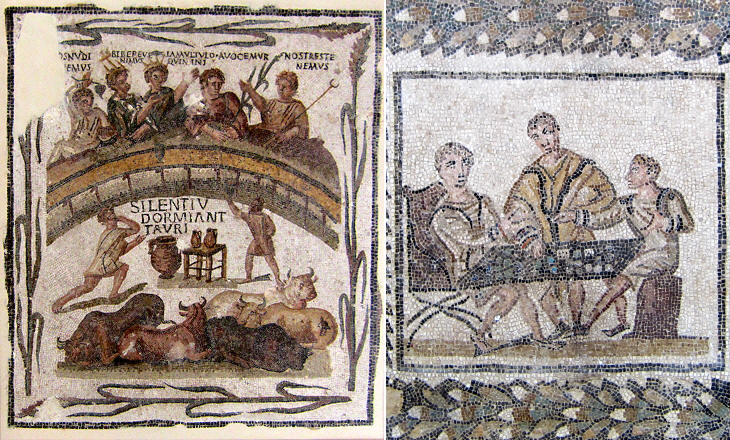
Mosaics from Thysdrus at the Museum of Bardo: (left) bulls in the arena; (right) detail of a larger mosaic known as the Cryptogram Chessboard showing dice players
The first mosaics found at Thysdrus were moved to the Museum of Bardo. The mosaics above show moments of relaxation at the amphitheatre or playing dice. The first one shows a banquet with those attending it saying some jokes: Bibere venimus (We are here to drink), Ia[m] multu[m] loquimini (You are all talking a lot) and Nos tres tenemus (We are three [glasses]), while one of the servants says: Silentiu[m] dormiant tauri equivalent to: let sleeping dogs lie. The overall meaning of the scene could be a reference to Horace's Carpe diem (Seize the present).
Roman law prohibited dice playing outside the week of Saturnalia (December 17-23), but the game was very popular and Emperor Augustus is said to have been addicted to it. Six was the score of Venus, one that of the dog. See a similar mosaic at Sepphoris in Galilee and a fresco at Pompeii.
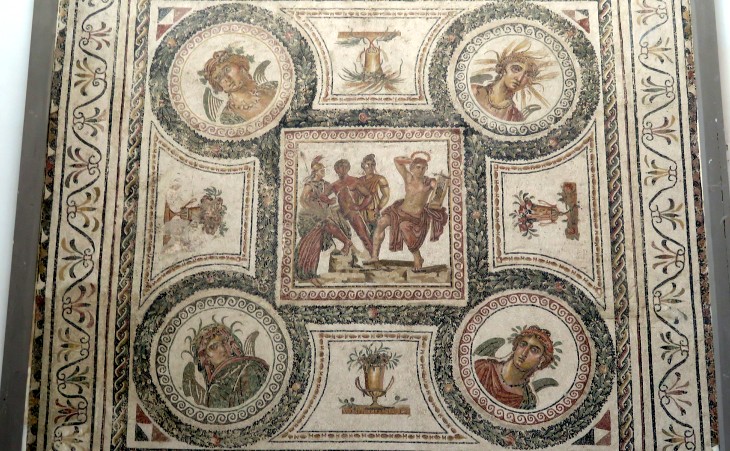
Mosaic from Thysdrus depicting the contest between Apollo and Marsyas and the Four Seasons (with wings)
The whole event can be split in three episodes which usually were depicted separately. A mosaic found at Kelibia shows Athena tossing away the double flute which will be picked up by Marsyas; this mosaic and many other ones e.g. near Marseille and at Paphos on Cyprus depict the contest between Marsyas and Apollo; the final episode, i.e. the gruesome punishment of Marsyas, was more often depicted in sarcophagi or statues at Rome.
Museum of Sousse

Mosaics from Thysdrus at the Archaeological Museum of Sousse showing mythological subjects: (left) the contest for Athens between Athena and Poseidon; (right) Achilles at Skyros
Other mosaics were moved to the Archaeological Museum of Sousse, the capital of the province which included El-Djem. The rather plain IVth century mosaic showing Athena and Poseidon was found in a house and it bears no relation to the adjoining long inscription (Livid Envious, you claimed that it was impossible to build this magnificent building; well! Look at this work that has come to a good end).
The episode of Achilles hiding among the daughters of the king of Skyros is not narrated by Homer in the Iliad, a poem with very few lighthearted passages, but in one written in Latin in ca 94-96 AD by Publius Papinius Statius. This episode became soon very popular because of its almost farcical account of a young man disguised as a girl. It was depicted even on glass cups.
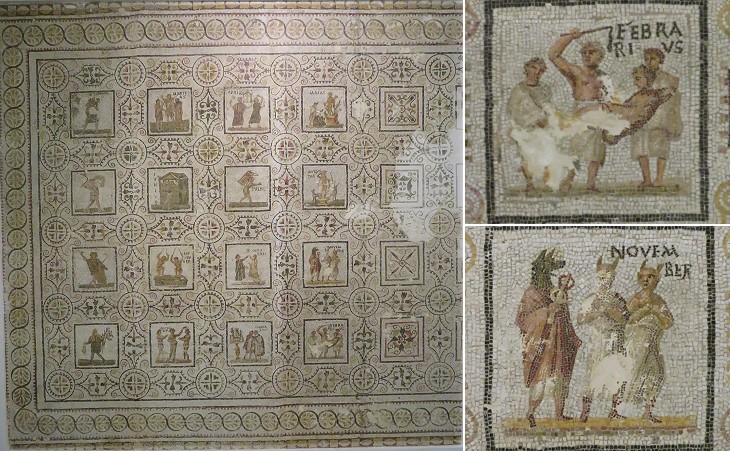
Mosaic from the House of the Months (the same of the Mosaic of the Nine Muses) at Thysdrus showing the Four Seasons and the Twelve Months
The Twelve Months of the Year were usually depicted as the Signs of the Zodiac, together with other periods of time, i.e. the Days of the Week at Ziqua or the Four Seasons at Sepphoris. This mosaic is a rare example (with a much later mosaic from Carthage) where the months of the year are depicted as such. The panel of February shows a metaphoric rite of fertility with a man hitting a woman in labor, February being the month preceding Spring. That of November shows Hermanubis, a god who combined Egyptian Anubis with Roman Mercury and two priests of Isis, a reference to the festival of Isis which ended on November 3.
Museum of Mahdia
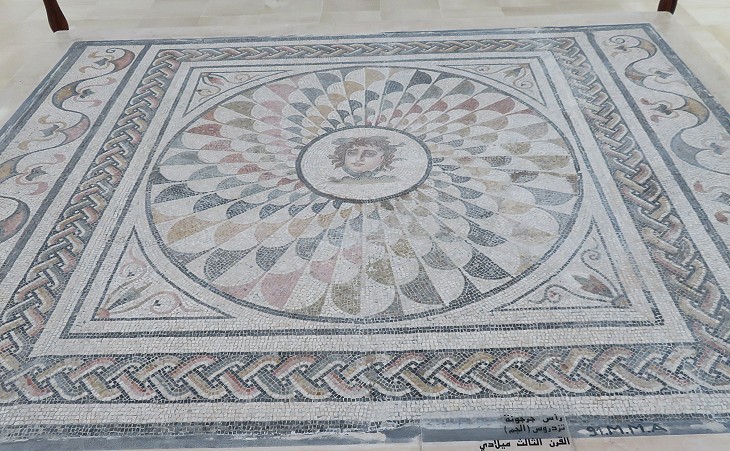
Museum of Mahdia: Mosaic of the Head of Medusa, a Gorgon
In 1974 Mahdia became the provincial capital of El-Djem and some mosaics from Thysdrus were moved to a small museum there. The Head of Medusa had the power of chasing evil spirits and it was often depicted on sarcophagi, e.g. at Antalya. This mosaic is almost identical to mosaics at Thapsus and in the Museum of Sousse and even to one at Pergamum in Turkey.
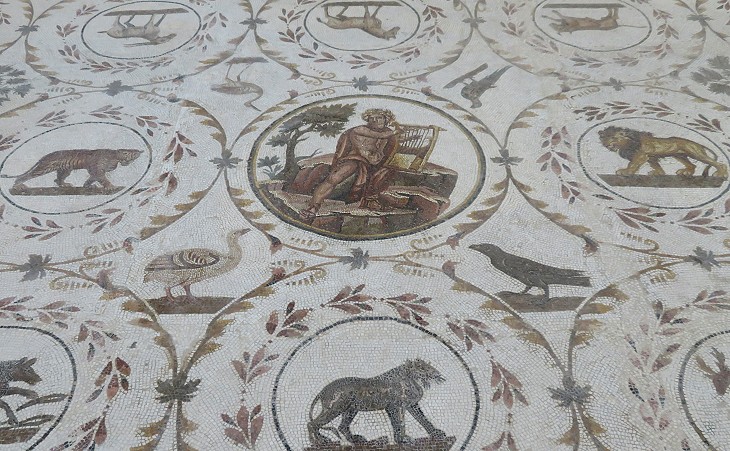
Mosaic of Orpheus taming the animals (similar to another one shown in the page)
In this mosaic Orpheus does not wear his traditional Phrygian cap and he resembles very much Apollo. He is portrayed in a landscape rather than against a white background. This landscape can be seen also in other mosaic of Orpheus, e.g. at Antioch and is a reference to the Rhodopes, his native rocky mountains between Greece and Bulgaria or to Mount Pangaion where he died.
Museum of Sfax
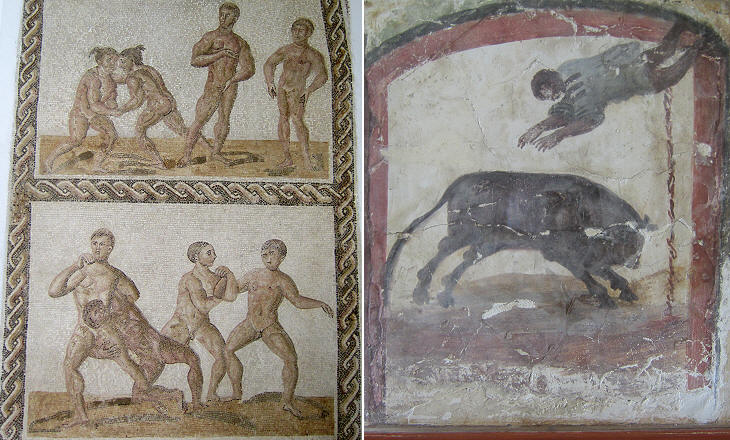
Museum of Sfax: (left) Wrestlers with the pig-tail hairstyle which was typical of Roman athletes of the IIIrd century (see similar mosaics at Dion and at the Baths or Caracalla in Rome); (right) fresco on a tomb showing a scene of bullfighting (or perhaps a bull-leaping exercise)
Sfax is the second largest city of Tunisia. It is situated on the coast some forty miles south of El-Djem. Its collection of mosaics is housed in some rooms of the Town Hall, which are at present (2012) unfit for appropriately displaying their exhibits which mainly come from Thaenae, a nearby Roman harbour.
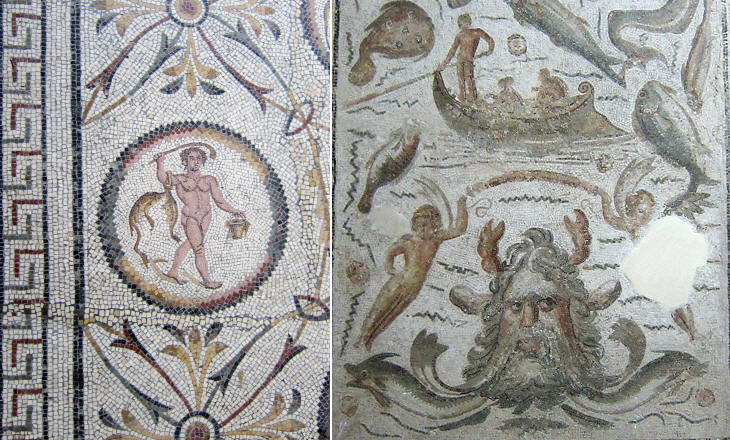
(left) Detail of a mosaic portraying a follower of Dionysus; (right) sea creatures surrounding a head of Oceanus, a very popular subject, e.g. at Sousse and at Utica
The museum is small but its exhibits show an almost complete catalogue of Roman mosaics in Tunisia.
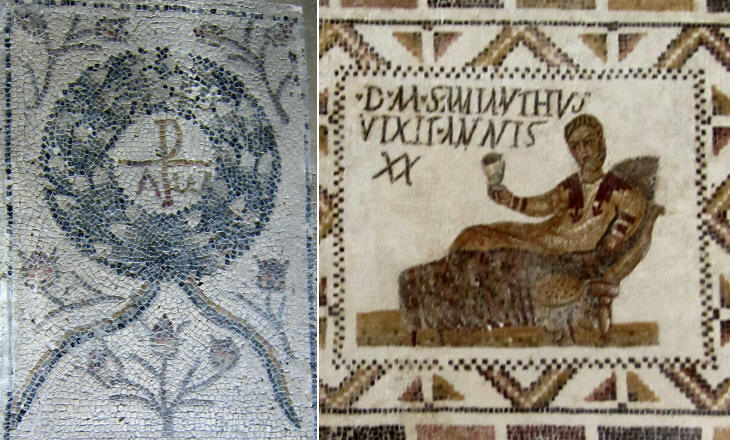
(left) A mosaic depicting a Chi-Rho, Christ's monogram on a tombstone; (right) the dead, a Pagan, attending his funerary banquet, a popular subject in tomb paintings and sarcophagi, less so in mosaics
The image in the background of this page shows a decorative mosaic in the Museum of El-Djem. The pattern is based on peltas, the shields of the Amazons.